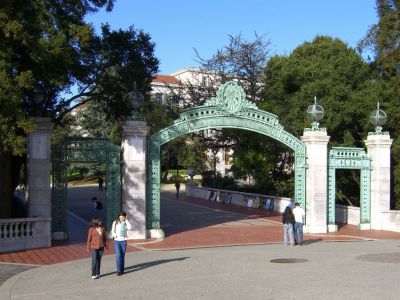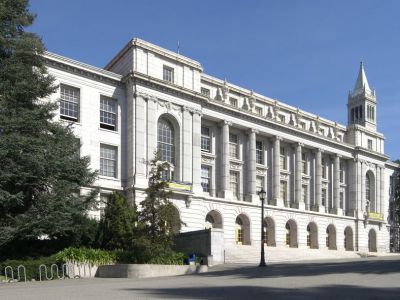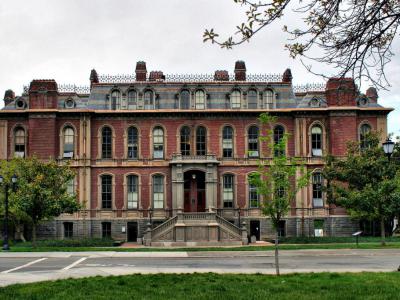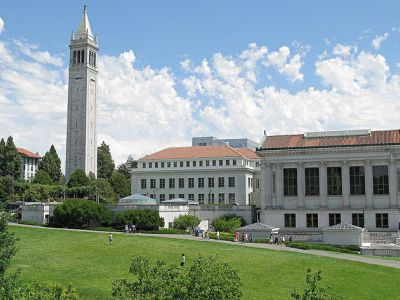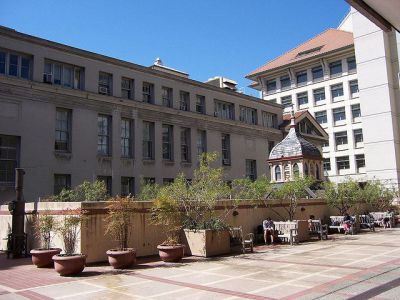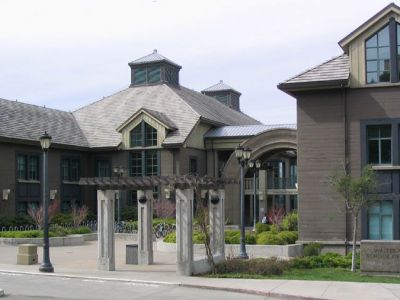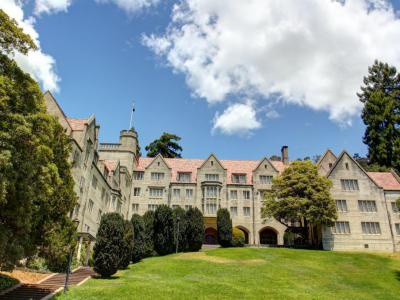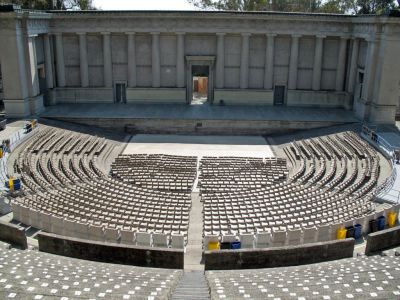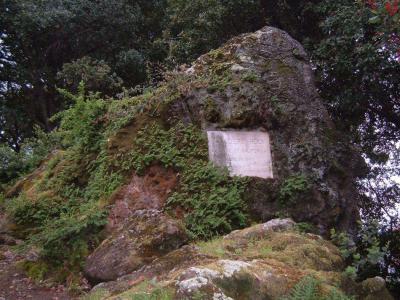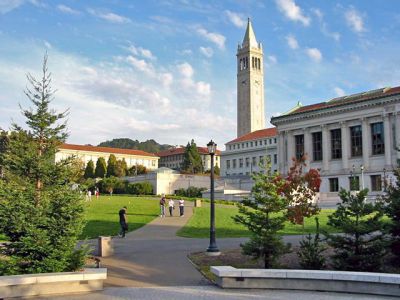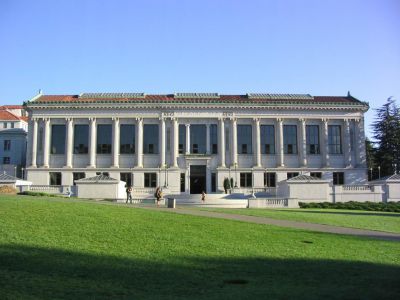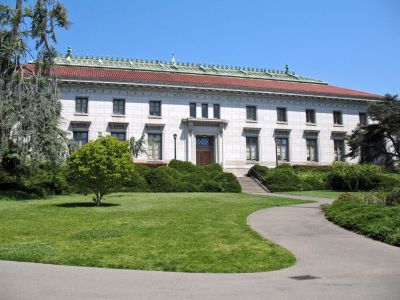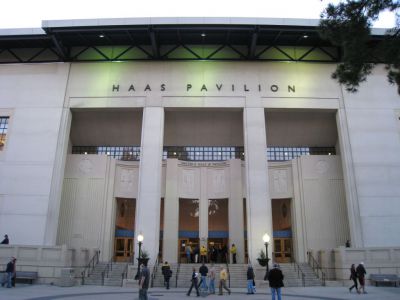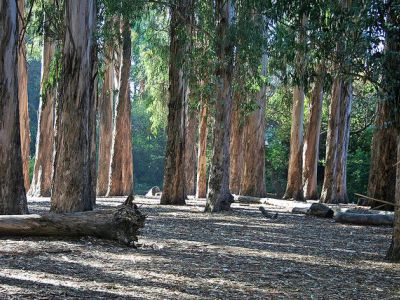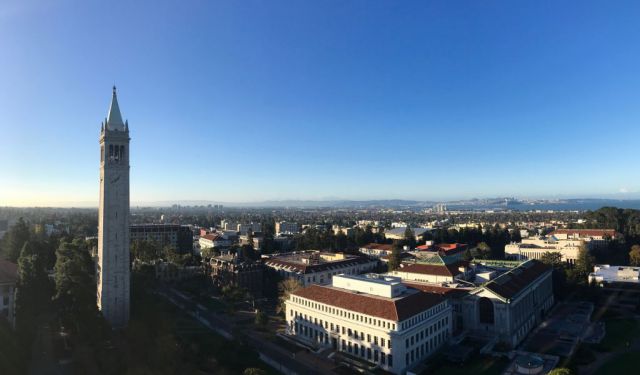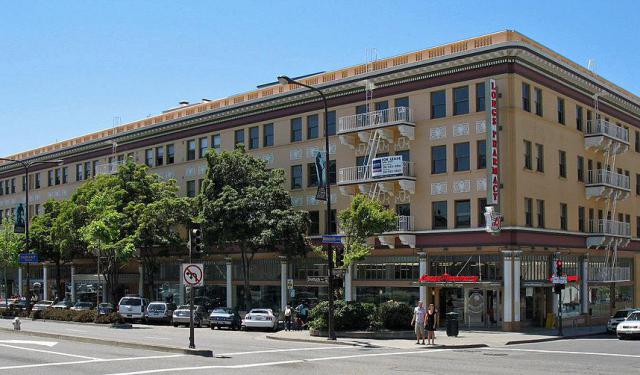
University of California in Berkeley Walking Tour (Self Guided), Berkeley
The University of California, Berkeley, often referred to as UC Berkeley or simply Berkeley, is a part of the larger University of California system, known for its distinguished academics and vibrant campus life. The UC Berkeley campus is the core of Berkeley's attractions. Its design resulted from an 1898 architectural competition, with each building having its own story to tell.
Start your walk at Sather Gate, an iconic entrance on campus, that throughout decades has welcomed numerous generations of students and visitors alike as a symbol of academic pursuit and achievement. Nearby, Wheeler Hall and South Hall are prominent academic buildings where students attend classes and engage in intellectual exploration.
Sather Tower, affectionately known as the Campanile, is a majestic clock tower that offers panoramic views of the Bay Area. Gilman Hall is another notable building, housing various research facilities.
The Haas School of Business is a hub for aspiring entrepreneurs and business leaders, while Bowles Hall provides a unique residential experience, fostering a sense of community.
The Hearst Greek Theatre is a stunning outdoor venue for concerts and performances. Founders' Rock and Memorial Glade are tranquil spots for reflection and relaxation.
Doe Memorial Library is the heart of academic research, while California Hall is home to the university's administration.
Those keen on sports should check out Haas Pavilion which regularly hosts student games, whereas the Eucalyptus Grove provides a serene backdrop to campus life.
Berkeley is a place where ideas flourish and diversity thrives. If you're considering higher education or just looking to visit, come and become part of the tradition, innovation, and excellence at UC Berkeley – an inspiring experience you wouldn't want to miss!
Start your walk at Sather Gate, an iconic entrance on campus, that throughout decades has welcomed numerous generations of students and visitors alike as a symbol of academic pursuit and achievement. Nearby, Wheeler Hall and South Hall are prominent academic buildings where students attend classes and engage in intellectual exploration.
Sather Tower, affectionately known as the Campanile, is a majestic clock tower that offers panoramic views of the Bay Area. Gilman Hall is another notable building, housing various research facilities.
The Haas School of Business is a hub for aspiring entrepreneurs and business leaders, while Bowles Hall provides a unique residential experience, fostering a sense of community.
The Hearst Greek Theatre is a stunning outdoor venue for concerts and performances. Founders' Rock and Memorial Glade are tranquil spots for reflection and relaxation.
Doe Memorial Library is the heart of academic research, while California Hall is home to the university's administration.
Those keen on sports should check out Haas Pavilion which regularly hosts student games, whereas the Eucalyptus Grove provides a serene backdrop to campus life.
Berkeley is a place where ideas flourish and diversity thrives. If you're considering higher education or just looking to visit, come and become part of the tradition, innovation, and excellence at UC Berkeley – an inspiring experience you wouldn't want to miss!
How it works: Download the app "GPSmyCity: Walks in 1K+ Cities" from Apple App Store or Google Play Store to your mobile phone or tablet. The app turns your mobile device into a personal tour guide and its built-in GPS navigation functions guide you from one tour stop to next. The app works offline, so no data plan is needed when traveling abroad.
University of California in Berkeley Walking Tour Map
Guide Name: University of California in Berkeley Walking Tour
Guide Location: USA » Berkeley (See other walking tours in Berkeley)
Guide Type: Self-guided Walking Tour (Sightseeing)
# of Attractions: 14
Tour Duration: 2 Hour(s)
Travel Distance: 3.1 Km or 1.9 Miles
Author: AudreyB
Sight(s) Featured in This Guide:
Guide Location: USA » Berkeley (See other walking tours in Berkeley)
Guide Type: Self-guided Walking Tour (Sightseeing)
# of Attractions: 14
Tour Duration: 2 Hour(s)
Travel Distance: 3.1 Km or 1.9 Miles
Author: AudreyB
Sight(s) Featured in This Guide:
- Sather Gate
- Wheeler Hall
- South Hall
- Sather Tower
- Gilman Hall
- Haas School of Business
- Bowles Hall
- Hearst Greek Theatre
- Founders' Rock
- Memorial Glade
- Doe Memorial Library
- California Hall
- Haas Pavilion
- Eucalyptus Grove, UC Berkeley
1) Sather Gate (must see)
Walking to the center of the University of California Berkeley from Sproul Plaza, visitors will find themselves at Sather Gate. Most will have undoubtedly seen photographs of Sather Gate from the 1960s Free Speech movement.
Sather Gate, like Sather Tower, was a gift to the University of California Berkeley from Jane Sather. She donated the funding for the gate in memory of her late husband, Peder Sather. This gate was built in 1910 in the Classical Revival Beaux-Arts architectural style from a design by John Galen Howard and sculptor Earl Cummings.
Cummings originally designed the gate with panels that depicted nude men and women who represented different areas of study. The panels were scandalous at the time and were removed by request of the benefactor. Those panels went missing until 1977 when they were discovered in a storage area beneath Edwards Stadium. Student petitions led to the panels being reinstalled on the gates, where they have been since 1979.
The gate is on the National Register of Historic Places and is a California Historical Landmark.
Sather Gate, like Sather Tower, was a gift to the University of California Berkeley from Jane Sather. She donated the funding for the gate in memory of her late husband, Peder Sather. This gate was built in 1910 in the Classical Revival Beaux-Arts architectural style from a design by John Galen Howard and sculptor Earl Cummings.
Cummings originally designed the gate with panels that depicted nude men and women who represented different areas of study. The panels were scandalous at the time and were removed by request of the benefactor. Those panels went missing until 1977 when they were discovered in a storage area beneath Edwards Stadium. Student petitions led to the panels being reinstalled on the gates, where they have been since 1979.
The gate is on the National Register of Historic Places and is a California Historical Landmark.
2) Wheeler Hall (must see)
Wheeler Hall is arguably the most recognizable building on the University of California Berkeley campus. It is the site that is often featured in representations of the university and the building that houses Berkeley's largest lecture hall. It is home to the university's English department.
Wheeler Hall is designed in the Classical Revival architectural style by architect John Galen Howard. His designs are seen throughout the Berkeley campus, including Sather Tower, Sather Gate and the Memorial Stadium. Wheeler Hall was completed in 1917 to take place of North Hall. The cost of construction was $715,994.
The building was closed in recent years in order to undergo a complete operational transformation. The facade was not changed, but Wheeler Hall was retrofitted with air conditioning, elevators and wireless communication.
Wheeler Hall has undergone a number of other updates and restorations over time. Great pains have been taken to ensure that all historic details have been preserved throughout these projects. Rather than replacing features of the building, many have been refurbished. One exception to this is the auditorium. The original was built in March 1917 but was destroyed by an arsonist in 1969.
Stopping by the iconic Wheeler Hall steps brings back images of Free Speech protests from the 1960s. Visitors can also imagine speeches by great figures from history like Dr. Martin Luther King, Jr. The hall is easy to reach by foot as it is located just steps away from Sather Gate and south of Doe Library.
Wheeler Hall is designed in the Classical Revival architectural style by architect John Galen Howard. His designs are seen throughout the Berkeley campus, including Sather Tower, Sather Gate and the Memorial Stadium. Wheeler Hall was completed in 1917 to take place of North Hall. The cost of construction was $715,994.
The building was closed in recent years in order to undergo a complete operational transformation. The facade was not changed, but Wheeler Hall was retrofitted with air conditioning, elevators and wireless communication.
Wheeler Hall has undergone a number of other updates and restorations over time. Great pains have been taken to ensure that all historic details have been preserved throughout these projects. Rather than replacing features of the building, many have been refurbished. One exception to this is the auditorium. The original was built in March 1917 but was destroyed by an arsonist in 1969.
Stopping by the iconic Wheeler Hall steps brings back images of Free Speech protests from the 1960s. Visitors can also imagine speeches by great figures from history like Dr. Martin Luther King, Jr. The hall is easy to reach by foot as it is located just steps away from Sather Gate and south of Doe Library.
3) South Hall (must see)
The oldest building on the University of California Berkeley campus is South Hall. It is also the only building that is original to the university that is still standing today. South Hall was completed in 1973 from a design by Farquharson and Kenitzer in the Second Empire architectural style.
South Hall has served a number of functions over the years. Its first purpose was as the home of the School of Agriculture. Over time, it also hosted the business school, the economics department, the School of Political Science and Sociology, the library school, a museum and an herbarium. It was also the location of the country's first physics lab.
South Hall is still in use as part of Berkeley's graduate school. The Berkeley School of Information is housed in South Hall and is comprised of classrooms, student lounges and work spaces. It has been reconfigured to allow for built-in projectors, audio equipment and wifi.
South Hall has served a number of functions over the years. Its first purpose was as the home of the School of Agriculture. Over time, it also hosted the business school, the economics department, the School of Political Science and Sociology, the library school, a museum and an herbarium. It was also the location of the country's first physics lab.
South Hall is still in use as part of Berkeley's graduate school. The Berkeley School of Information is housed in South Hall and is comprised of classrooms, student lounges and work spaces. It has been reconfigured to allow for built-in projectors, audio equipment and wifi.
4) Sather Tower (must see)
The bell tower on the University of California Berkeley campus is called Sather Tower. It was a gift from Jane K. Sather in memory of her husband, Peder. He was a prominent banker and a trustee of the university.
Jane Sather was a well known suffragist and philanthropist. She was a major benefactor in the early days of the Berkeley campus, providing donations in both land and money. The initial $75,000 she gave to the University would be the equivalent of nearly $2 million in today's fund. Sather Tower was an even more robust donation. The $200,000 price tag for the tower translates to more than $5 million in today's rates.
Sather Tower is a Gothic Revival style bell tower with clocks on all four faces. It was designed by architect John Galen Howard who modeled it after the St. Mark's Square Campanile in Venice. It is the third tallest clock tower in the world and the tallest bell tower outside of Italy, standing at 307 feet tall. There is an observation deck on the tower's eighth floor that has views of San Francisco and the Golden Gate Bridge.
The tower originally held a 12-bell chime. It has been expanded over the years and now contains a 61-bell, full concert carillon. It is performed on regular intervals during the spring and fall semesters and irregularly throughout the rest of the year. The Department of Music at Berkeley offers carillon classes to those who can pass the rigorous musical audition.
Many fossils, particularly those found at the La Brea Tar Pits, are stored within the tower
Why You Should Visit:
- To see the tallest bell tower in the world outside of Italy
- To take in the views of San Francisco
Tips:
The cost to visit Sather Tower is $4 for each person over the age of 17. Children are free. There is no need to worry about climbing steps to get to the observation deck as there is an elevator inside that will take tourists to the eighth floor.
Jane Sather was a well known suffragist and philanthropist. She was a major benefactor in the early days of the Berkeley campus, providing donations in both land and money. The initial $75,000 she gave to the University would be the equivalent of nearly $2 million in today's fund. Sather Tower was an even more robust donation. The $200,000 price tag for the tower translates to more than $5 million in today's rates.
Sather Tower is a Gothic Revival style bell tower with clocks on all four faces. It was designed by architect John Galen Howard who modeled it after the St. Mark's Square Campanile in Venice. It is the third tallest clock tower in the world and the tallest bell tower outside of Italy, standing at 307 feet tall. There is an observation deck on the tower's eighth floor that has views of San Francisco and the Golden Gate Bridge.
The tower originally held a 12-bell chime. It has been expanded over the years and now contains a 61-bell, full concert carillon. It is performed on regular intervals during the spring and fall semesters and irregularly throughout the rest of the year. The Department of Music at Berkeley offers carillon classes to those who can pass the rigorous musical audition.
Many fossils, particularly those found at the La Brea Tar Pits, are stored within the tower
Why You Should Visit:
- To see the tallest bell tower in the world outside of Italy
- To take in the views of San Francisco
Tips:
The cost to visit Sather Tower is $4 for each person over the age of 17. Children are free. There is no need to worry about climbing steps to get to the observation deck as there is an elevator inside that will take tourists to the eighth floor.
5) Gilman Hall
Gilman Hall is a building on the campus of the University of California. Room 307 was where Glenn T. Seaborg and his coworkers identified plutonium as a new element on February 23, 1941. Today Room 307 is designated a National Historic Landmark and the building itself is designated a National Historic Chemical Landmark, recognizing the two Nobel Prizes in Chemistry that have resulted from research done in the building.
Gilman Hall has been used continuously by the College of Chemistry for 80 years; today it is occupied by the Department of Chemical Engineering. However, its laboratory equipment is no longer suitable for modern chemical research and as such, the University has renovated and converted some of the rooms into offices, classrooms, and small research laboratories.
Gilman Hall has been used continuously by the College of Chemistry for 80 years; today it is occupied by the Department of Chemical Engineering. However, its laboratory equipment is no longer suitable for modern chemical research and as such, the University has renovated and converted some of the rooms into offices, classrooms, and small research laboratories.
Sight description based on Wikipedia.
6) Haas School of Business
The Walter A. Haas School of Business, also known as the Haas School of Business or simply Haas, is one of 14 schools and colleges at the University of California.
The school is situated in three connected buildings surrounding a central courtyard on the southeastern corner of the Berkeley campus. The final design of architect Charles Moore, the mini-campus was completed in 1995. The school is planning to expand its facilities with a new commons building shared with the Berkeley School of Law. It constantly ranks as one of the top ten business schools in worldwide rankings published by The Economist, US News & World Report, and Bloomberg Businessweek.
The school is situated in three connected buildings surrounding a central courtyard on the southeastern corner of the Berkeley campus. The final design of architect Charles Moore, the mini-campus was completed in 1995. The school is planning to expand its facilities with a new commons building shared with the Berkeley School of Law. It constantly ranks as one of the top ten business schools in worldwide rankings published by The Economist, US News & World Report, and Bloomberg Businessweek.
Sight description based on Wikipedia.
7) Bowles Hall
Bowles Hall is an all-male residence dormitory at the University of California, world renowned for its unique traditions, legendary parties and camaraderie.
The dormitory was the first residence hall on campus, dedicated in 1929, and was California's first state-owned dormitory. It was built in 1928 on a $350,000 grant by Mary McNear Bowles in memory of her husband, Cal alumnus and UC Regent Phillip E. Bowles. Mr. Bowles was said to have three loves, Horses, Horticulture and the University of California.
The Hall displays the unique and formidable appearance of a medieval castle, with a stone exterior and a lush wood entryway. Although a University-operated residence hall, its male-only tradition, classic facade, partitioned four-man rooms, and community facilities give it a feeling much closer to that of a social fraternity. Bowlesmen have traditionally been a tight-knit group of students who regularly practice various traditions and rituals that are exclusive to the Hall. In the 1980s, it was listed in the National Register of Historic Places, a prime example of the style of architecture called 'Collegiate Gothic'. The building is still being used as an all-men's residence up to this day, although some traditions have not survived.
The dormitory was the first residence hall on campus, dedicated in 1929, and was California's first state-owned dormitory. It was built in 1928 on a $350,000 grant by Mary McNear Bowles in memory of her husband, Cal alumnus and UC Regent Phillip E. Bowles. Mr. Bowles was said to have three loves, Horses, Horticulture and the University of California.
The Hall displays the unique and formidable appearance of a medieval castle, with a stone exterior and a lush wood entryway. Although a University-operated residence hall, its male-only tradition, classic facade, partitioned four-man rooms, and community facilities give it a feeling much closer to that of a social fraternity. Bowlesmen have traditionally been a tight-knit group of students who regularly practice various traditions and rituals that are exclusive to the Hall. In the 1980s, it was listed in the National Register of Historic Places, a prime example of the style of architecture called 'Collegiate Gothic'. The building is still being used as an all-men's residence up to this day, although some traditions have not survived.
Sight description based on Wikipedia.
8) Hearst Greek Theatre
The William Randolph Hearst Greek Theatre, known locally as simply the Greek Theatre, is an 8,500-seat amphitheater owned and operated by the University of California.
The Greek Theatre hosts The Berkeley Jazz Festival, pop, rock, and world music concerts, UC Berkeley graduation ceremonies, occasional addresses by noted speakers, and other events. Past speakers include President Theodore Roosevelt, William Randolph Hearst, and the Dalai Lama.
The Greek Theater was built in 1903 on the site of a rough outdoor bowl already in use as an amphitheater since 1894 known as "Ben Weed's Amphitheater". The project was championed by University of California president Benjamin Ide Wheeler and was the first University building designed by John Galen Howard. Its construction was financed by newspaper magnate William Randolph Hearst, after whom it was named. The design of the theater is based directly on the ancient Greek theater of Epidaurus.
The Greek Theatre hosts The Berkeley Jazz Festival, pop, rock, and world music concerts, UC Berkeley graduation ceremonies, occasional addresses by noted speakers, and other events. Past speakers include President Theodore Roosevelt, William Randolph Hearst, and the Dalai Lama.
The Greek Theater was built in 1903 on the site of a rough outdoor bowl already in use as an amphitheater since 1894 known as "Ben Weed's Amphitheater". The project was championed by University of California president Benjamin Ide Wheeler and was the first University building designed by John Galen Howard. Its construction was financed by newspaper magnate William Randolph Hearst, after whom it was named. The design of the theater is based directly on the ancient Greek theater of Epidaurus.
Sight description based on Wikipedia.
9) Founders' Rock (must see)
Founders' Rock is thought to be the spot where the founders of the University, originally the College of California, stood when they dedicated the property on April 16, 1860. It also thought to be the place where Frederick Billings stood when he chose the name Berkeley for the town.
Founders' Rock is a natural outcropping of rock that is thought to have been created by activity on the Hayward Fault. It was one of the most notable features in the area prior to the growth of the city. Now, its location at Hearst Avenue and Gayley Road is partially obscured by Cory Hall, which is home to the Berkeley school of Electrical Engineering and Computer Sciences.
Visitors can pinpoint Founders' Rock by looking for the plaque on the tallest point of the outcropping. The plaque was placed by the graduating class of 1896. It reads, "Founders' Rock, College of California, April 16 1860."
Founders' Rock is a natural outcropping of rock that is thought to have been created by activity on the Hayward Fault. It was one of the most notable features in the area prior to the growth of the city. Now, its location at Hearst Avenue and Gayley Road is partially obscured by Cory Hall, which is home to the Berkeley school of Electrical Engineering and Computer Sciences.
Visitors can pinpoint Founders' Rock by looking for the plaque on the tallest point of the outcropping. The plaque was placed by the graduating class of 1896. It reads, "Founders' Rock, College of California, April 16 1860."
Sight description based on Wikipedia.
10) Memorial Glade
Memorial Glade is a green space located at the core of the university campus. It is home to a variety of trees, including a grove of trident maples. Memorial Glade is a popular place for students to relax between classes and offers a great view of many other campus landmarks.
11) Doe Memorial Library
The main library on the UC Berkeley campus is Doe Memorial Library. It is located in the center of campus adjacent to Bancroft Library and popular student gathering spot, Memorial Glade.
The library was designed by architect Emile Benard, whose thumbprint can be seen on much of the Berkeley campus. The Neoclassical design of the building is primarily influenced by Benard's time at France's Ecole des Beaux Arts. The library was completed in 1911.
The main stacks of the Doe Memorial Library hold 52 miles books in a four-story underground structure. The library also includes classrooms, offices and exhibit space. It is easy to walk to and from the Bancroft Library from Doe Memorial as the two are connected via walkways on the first and second floors.
The general public is welcome to explore the library while visiting the UC Berkeley campus. However, only students of Berkeley or Stanford University may check out books and equipment. The library is a short walk from Sather Gate and Wheeler Hall.
The library was designed by architect Emile Benard, whose thumbprint can be seen on much of the Berkeley campus. The Neoclassical design of the building is primarily influenced by Benard's time at France's Ecole des Beaux Arts. The library was completed in 1911.
The main stacks of the Doe Memorial Library hold 52 miles books in a four-story underground structure. The library also includes classrooms, offices and exhibit space. It is easy to walk to and from the Bancroft Library from Doe Memorial as the two are connected via walkways on the first and second floors.
The general public is welcome to explore the library while visiting the UC Berkeley campus. However, only students of Berkeley or Stanford University may check out books and equipment. The library is a short walk from Sather Gate and Wheeler Hall.
12) California Hall
Also designed by John Galen Howard, California Hall is located in the center of the university campus. Completed in 1906, throughout the years it has undergone many renovations. This building is part of Howard's Beaux Arts architectural plan for the campus. Listed in the National Register of Historic Places, California Hall houses the university’s major administrative and personnel offices.
13) Haas Pavilion
The Walter A. Haas, Jr. Pavilion is the home of the University of California's men's and women's basketball, women's volleyball, and men's and women's gymnastics teams. The arena is located in the middle of the main University of California sports complex, overlooking Evans Diamond (baseball) and Edwards Stadium (track/soccer).
The arena was originally built in 1933 as the Men's Gym. It was renamed Harmon Gym in 1959, after Oakland financier A.K.P. Harmon, who donated the funds to build Cal's first indoor athletic facility in 1879. Lou Campanelli tried to have it renamed "Harmon Arena" when he became coach, but it never really caught on. The playing surface, after being known as simply "Room 100" since the arena opened, was renamed Pete Newell Court in 1987 in honor of Pete Newell, who led Cal to the national championship in 1959.
The arena was originally built in 1933 as the Men's Gym. It was renamed Harmon Gym in 1959, after Oakland financier A.K.P. Harmon, who donated the funds to build Cal's first indoor athletic facility in 1879. Lou Campanelli tried to have it renamed "Harmon Arena" when he became coach, but it never really caught on. The playing surface, after being known as simply "Room 100" since the arena opened, was renamed Pete Newell Court in 1987 in honor of Pete Newell, who led Cal to the national championship in 1959.
Sight description based on Wikipedia.
14) Eucalyptus Grove, UC Berkeley
The University of California Berkeley campus has many notable sites and interesting places. One of the most unique is the eucalyptus grove that rests behind the Berkeley Art Museum and Pacific Film Archive.
The grove was planted in 1882 to create a windbreak for a running track that is no longer in place. The Tasmanian blue gums were chosen because they grow tall and strong with great speed.They also do not naturally provide food for any animals in the United States, which keeps their growth from being halted. In addition to this, disease causing insects rarely invade the eucalyptus tree. They stay healthy with very little upkeep.
Eucalyptus is not without controversy in California. The trees are an invasive species that have taken great swaths of native habitat. They are also highly flammable, which make them particularly dangerous in California. The medicinal smell that emanates from the trees is one that beloved by some and bemoaned by others.
Still, the uniqueness of the grove should not be missed. The Eucalyptus Grove at UC Berkeley is the tallest and densest grove of Tasmanian blue gums in the world. It is also the tallest stand of hardwood trees in the continent.
The grove was planted in 1882 to create a windbreak for a running track that is no longer in place. The Tasmanian blue gums were chosen because they grow tall and strong with great speed.They also do not naturally provide food for any animals in the United States, which keeps their growth from being halted. In addition to this, disease causing insects rarely invade the eucalyptus tree. They stay healthy with very little upkeep.
Eucalyptus is not without controversy in California. The trees are an invasive species that have taken great swaths of native habitat. They are also highly flammable, which make them particularly dangerous in California. The medicinal smell that emanates from the trees is one that beloved by some and bemoaned by others.
Still, the uniqueness of the grove should not be missed. The Eucalyptus Grove at UC Berkeley is the tallest and densest grove of Tasmanian blue gums in the world. It is also the tallest stand of hardwood trees in the continent.
Walking Tours in Berkeley, California
Create Your Own Walk in Berkeley
Creating your own self-guided walk in Berkeley is easy and fun. Choose the city attractions that you want to see and a walk route map will be created just for you. You can even set your hotel as the start point of the walk.
Berkeley Introduction Walking Tour
The Ohlone people were the original inhabitants of the area that is now known as Berkeley, California. Many of them were casualties of the presence of the first settlers of European descent who arrived with the De Anza Expedition of 1776.
Among the soldiers in this expedition was Luis Peralta, who was gifted the land that would become Berkeley by the King of Spain. Peralta gifted the land to... view more
Tour Duration: 2 Hour(s)
Travel Distance: 2.3 Km or 1.4 Miles
Among the soldiers in this expedition was Luis Peralta, who was gifted the land that would become Berkeley by the King of Spain. Peralta gifted the land to... view more
Tour Duration: 2 Hour(s)
Travel Distance: 2.3 Km or 1.4 Miles
Berkeley's Historic Landmarks Walking Tour
Berkeley, California, boasts a fair amount of landmarks distinguished for their historical value and representative of the city’s architectural beauty.
One such gem is the Thorsen House, an iconic residence designed by the renowned architectural firm Greene and Green, showcasing the American Craftsman style.
The First Church of Christ, Scientist, is another notable sight. Its mixed design... view more
Tour Duration: 3 Hour(s)
Travel Distance: 4.5 Km or 2.8 Miles
One such gem is the Thorsen House, an iconic residence designed by the renowned architectural firm Greene and Green, showcasing the American Craftsman style.
The First Church of Christ, Scientist, is another notable sight. Its mixed design... view more
Tour Duration: 3 Hour(s)
Travel Distance: 4.5 Km or 2.8 Miles
Telegraph Avenue Shopping
In addition to other attractions, the colorful and joyful city of Berkeley, California offers a wide variety of places to shop. Perhaps the most notable among them is Telegraph Avenue, a vibrant and eclectic thoroughfare, featuring a unique blend of cultural diversity and youthful energy.
One of the standout landmarks on Telegraph Avenue is the Berkeley Hat Company. Here, you'll find an... view more
Tour Duration: 1 Hour(s)
Travel Distance: 0.6 Km or 0.4 Miles
One of the standout landmarks on Telegraph Avenue is the Berkeley Hat Company. Here, you'll find an... view more
Tour Duration: 1 Hour(s)
Travel Distance: 0.6 Km or 0.4 Miles
The Most Popular Cities
/ view all
